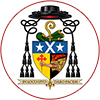Professor Richard Fawcett OBE speaking at Pluscarden Abbey
On Friday 4 November Professor Richard Fawcett OBE gave an illustrated Talk to the community on the buildings we live in.
Dr. Fawcett is Emeritus Professor of Architectural History at the University of St. Andrews in Fife. Among his many other titles, he is a Fellow of the Royal Society of Edinburgh, and a Fellow of the Societies of Antiquaries of London and of Scotland. A recently published book of his is on "The Architecture of the Scottish Mediaeval Church, 1100 - 1560" (Yale 2011). Currently Dr. Fawcett is leading a research project on the Mediaeval Parish Churches of Scotland. More than once he said that the Pluscarden collection of buildings is his favourite in the country: and indeed he probably knows more about them than anyone else alive.
The Talk was lively and most interesting. In particular Dr. Fawcett illustrated features of our architecture by comparison with other buildings, whether in Scotland or in Europe as a whole. Of course the frequent adaptations or radical re-buildings over the centuries mean that some enigmas remain impossible to solve. Nevertheless, with a certain amount of educated guess work, we can be fairly confident about what Pluscarden would have looked like in around, say, 1270 (when the initial building phase was completed), and 1400 (after the presumed deliberate destruction by the Wolf of Badenoch), and 1470 (after the re-building campaign by the Benedictines), and 1560 (when monastic life became illegal, along with the practice of the Catholic Faith). We can also guess at what was probably planned but never completed, such as a higher tower, and perhaps various features of the Nave.
Other less strictly architectural matters of historical interest were touched on: such as the foundation of three Valliscaulian Houses in Scotland, all at around the same time, in the year 1230; with Pluscarden by far the grandest, and the only one with Royal patronage. Or: why a King of Scotland at the time might want to spend so lavishly on such a project at all? Or: what was the relation between the masons who constructed Pluscarden, and those who built Elgin Cathedral? Or: what currents of thought and experience were influencing the Pluscarden masons; and why is the design of our North Transept so different from that of the South Transept? Or: where were the Choir Stalls, and where were the side Altars?
We are extremely grateful to Professor Fawcett for coming to speak to us about all this. Some of it we knew; some of it we thought we knew, but didn't really; some of it was completely new to us. We hope we will have other opportunities in future to benefit from Professor Fawcett's vast knowledge and expertise in all matters to do with Scottish mediaeval history and Church architecture.


